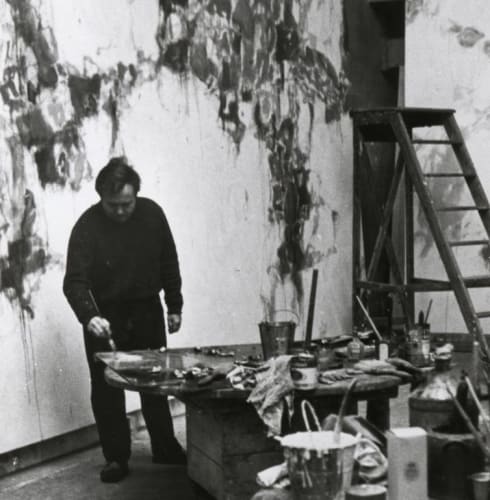Sam Francis was born in San Mateo, California (USA), on June 25, 1923. During the Second World War he enlisted as a pilot in the Air Force but during his service he was diagnosed with spinal tuberculosis. It is precisely during the course of his hospitalization that Francis, after receiving a visit from the painter David Park, begins to paint: suspended in mid-air with a harness on a hospital bed, approaches for the first time to painting as a form of therapy.
The path of a career lived between three different continents, which will consecrate him as an "international artist" par excellence, begins with Francis' move from California to Paris in 1950. In the French capital, he started being known with works that testify the influence of Abstract Expressionism's masters such as Arshile Gorky, Mark Rothko and Clyfford Still. Sam Francis's research would develop shortly thereafter taking as references some representatives of the second generation of Abstract Expressionism: Joan Mitchell and Helen Frankenthaler. But also French masters such as Henri Matisse, Pierre Bonnard and Claude Monet - in particular the chromatic deflagration of his water lilies - are for Francis points of reference and sources of inspiration. The study of the potential of color in the atmospheric rendering of space, the conception of its use freed from representative intentions, begin to define the pictorial language of Francis that in France starts being associated with Tachisme, with the support of critics such as Michel Tapié and Claude Duthuit.
Sam Francis married five times: the first, with one of his college classmates, Vera Miller, which lasted from 1947 to 1952, the second, from 1955 to 1958, with Muriel Goodwin, the third and fourth marriages, respectively, with Teruko Yokoi (with whom his daughter Kayo was born) and to Maku Idemitsu, by whom he had two sons (Osamu and Shingo). These last two marriages denote Francis' connection with Japan, a country where the artist celebrated his fifth and last marriage, joining Margareth Smith in a Shinto ceremony.
A connection with the Japanese world that Francis has since the fifties, when he began his long journeys in the country: Calligraphy and Japanese art deeply mark the creative path of the artist, who makes his own the "haboku", a technique of dripping and ink launched with which Francis realizes his canvases and his graphic works. Enamored of printing processes, between 1970 and 1974 he became particularly active in the production of lithographs, aquatints and monotypes, so to found his own printing studio "The Litho Shop Inc". The spontaneous energy that characterizes these works is the same that can be found in the artist's paintings: vibrant color and a painterly appearance due to the application of ink on lithographic limestone and the creation of brushstrokes, sketches and drips. During the sixties he came back to California where he continued to paint, expecially in Los Angeles, but also in Tokyo where he lived mainly in 1973-1974. A further evolution of his work occurred after Francis began an intensive Jungian analysis with Dr. James Kirsch in 1971, thanks to which he began to pay attention to his dreams and the unconscious images they suggested.
In 1984 Francis founded "The Lapis Press" with the aim of producing texts related to poetry, fiction and contemporary art, with original and visually sophisticated formats and content.
In 1991, the artist was elected to the National Academy of Design as an associate member, becoming a full Academician in 1994.
During the last year of his life, suffering from prostate cancer and unable to paint with his right hand after a fall, he used his left hand to complete a series of approximately 150 small paintings before he died. After his death in Santa Monica in 1994, the Sam Francis Foundation was founded, with the mission to "research, document, protect and perpetuate the artist's creative legacy."
If between the end of the 1950s until the mid-1960s Sam Francis' works realized the highest prices among living artists, the artist's quotations registered important goals also in recent auctions, such as the Sotheby's one in New York in 2020, where an oil on canvas of 1956 (Deep Blue, Yellow, Red) was purchased for 7.941,849 euros or the one of Sotheby's in New York in 2016, where another oil on canvas (Summer #1, 1957) was purchased for 10,405,565 euros to enter The Broad Museum's collection.
Paintings by Sam Francis are held in international museum collections such as the Metropolitan Museum of Art; Museum of Modern Art, New York; Kunstmuseum Basel; Idemitsu Museum of Arts, Tokyo; the San Francisco Museum of Modern Art and the Centre Pompidou-Musee National d'Art Moderne, Paris.
In 2013 the Galleria d'Arte Maggiore g.a.m. hosted in the halls of its historical seat in Bologna an exhibition of Sam Francis realized with a wide selection of works aimed at reconstructing the path of the artist's career, from the initial influences of American Abstract Expressionism to the subsequent evolution of his language.
